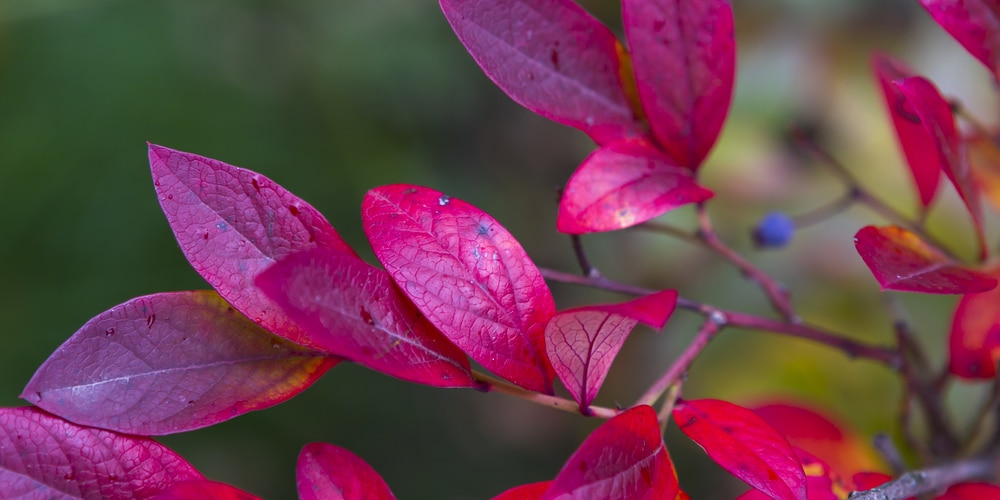Blueberries are very healthy as they are packed full of antioxidants and contain many beneficial vitamins and minerals. Many people grow their own blueberry plants to have a fresh supply of fruit for their families throughout the growing season. Blueberry plants turn red during the fall. This is normal and is nothing to worry about. The rest of the year, the leaves should be a nice bright green color.
If your blueberries have red leaves in the spring or summer, this indicates a problem. There are several different reasons that your blueberry leaves may have started to turn red. This article will answer the question, ‘why are my blueberries leaves turning red?’
Why are my blueberries leaves turning red?

As you’ll see below, there are A TON of reasons why your blueberries leaves may be turning red.
As the weather begins to cool down during fall, your blueberry leaves will start turning red. This is a natural response to colder weather. During the growing season, red leaves indicate that your plants aren’t healthy. They may be suffering from a phosphorus or magnesium deficiency.
Other common reasons blueberry leaves turn red include fungal or bacterial disease, cold exposure, or a cultural and nutritional problem. Let’s look at each of these problems in turn and discuss ways to improve the health of your plants.
Phosphorus Deficiency
If you notice your blueberry plants have started turning a deep maroon to red color in the spring, they are likely suffering from a phosphorus deficiency. Blueberries thrive in soil that’s acidic and has a pH of between 4.5 and 5.0. If your plant’s leaves have started to change color, the best thing to do is test your soil ph range and then make adjustments as necessary.
If your soil has a ph. of over 5.2, the blueberry plants won’t absorb enough phosphorus. You’ll need to increase the acidity of your soil by adding an organic compound such as manure, coffee, pine bark mulch, dried leaves, peat moss, or alfalfa meal.
Magnesium Deficiency
If your blueberry leaves look green, but the veins are red, the bushes aren’t getting enough magnesium which means they cannot produce enough chlorophyll. In the first stages of magnesium deficiency, your plant’s veins will start to turn yellow. If left untreated, they will turn red and then a brighter red. You’ll notice that younger leaves are the first to be affected.
To solve this problem, you can try adding a fertilizer that’s rich in magnesium or sprinkle some Epsom salts around the base of your blueberry plants. This will help to improve the magnesium in your soil.
Fungal Disease
It’s relatively common for blueberries to be affected by fungi disease and bacteria. Many of these diseases will cause your plant’s leaves to look red and mottled. Two of the most common conditions are Phomopsis twig blight and powdery mildew.
Phomopsis twig blight
If you notice that twigs and buds have developed a brown lesion, this is the first stage of Phomopsis twig blight. You’ll then see that the plant’s leaves and stems develop spots and become infected will wilt. In the latter stages of the disease, the leaves will turn red or brown.
It’s essential to treat your plants before the infection spreads to the fruit. If the fruit rots, it will ruin your harvest. Infected fruit will feel very soft and will split easily. You can get rid of the disease by pruning infected twigs. Ensure that you destroy the leaves and twigs rather than composting them, as this can stop the pathogen from spreading. You can also apply sulfur to the leaf buds.
Powdery Mildew
Powdery mildew is caused by fungal growth. You’ll first notice that the leaves appear to have a white growth that’s slightly fluffy in appearance. Within a week or two, the leaves will then start to develop red borders, as well as chlorotic spots. If left untreated, the plant will drop its leaves.
Powdery mildew is most common in warm climates with dry air conditions. You can apply a foliar fungicide that’s been designed to treat powdery mildew. Some products are available that will also prevent the disease.
Bacterial Disease
One of the most common reasons a blueberry plant’s leaves will turn red is due to ‘Blueberry leaf scorch’. This bacterial disease is caused by the bacteria Xylella fastidiosa. Plants suffering from the disease have a restricted flow of water and nutrients due to the bacteria sap, which restricts the plant’s intake.
If your plants are affected by blueberry leaf scorch, they will be less productive and will flower irregularly. The condition will eventually cause the plant to die.
If you have plants with Blueberry leaf scorch, you’ll need to remove the whole plant and destroy them. Don’t compost infected plants or take cuttings from them, as this could spread the disease. You can apply products containing neonicotinoid thiamethoxam to healthy plants as a preventative method.
Cultural Problems
Improper soil or location can cause reddening of the plant’s leaves. Blueberry leaves turn red when the plants are struggling to cope with the conditions. Plants that are grown in a cold place or in waterlogged soil or poorly drained soil will suffer and should be relocated. Alternatively, you can adjust the soil by adding pine bark to soak up any excess water.
Conclusion
Blueberry plant’s leaves turn red when the weather starts to get colder in the fall. This is nothing to worry about as it’s a natural response to cold exposure. Once the seasons change to spring, your blueberry leaves will turn green again. If the leaf color remains red, even when the weather gets warmer, this indicates that there’s likely to be another underlying issue.
The above list of problems can help you work out what’s wrong with your blueberries and will allow you to solve the problem. You’ll need to take good care of your blueberry plants if they are to thrive and produce a good harvest of fruit.
Related: Do Blueberries Have Seeds?